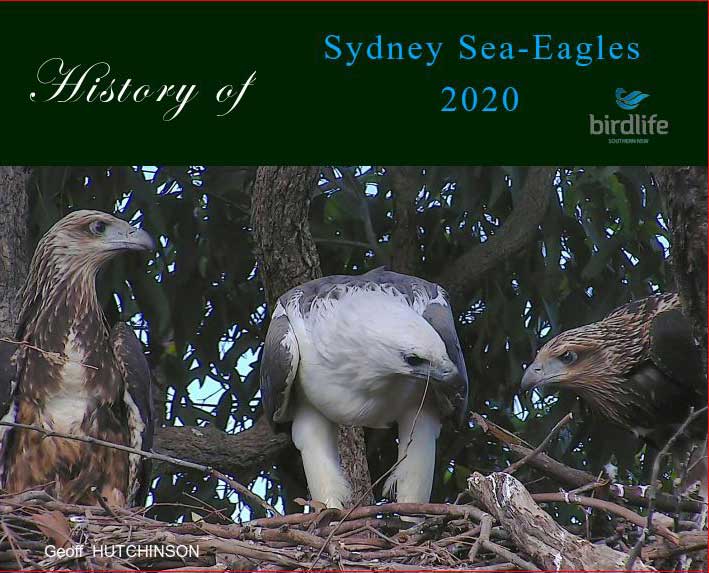Judy Harrington, Geoff Hutchinson, Jon Irvine, BirdLife Southern NSW.
There has been a Sea-Eagle nest in the Newington Nature Reserve at Sydney Olympic Park by the Parramatta River for many years, with a succession of eagle pairs renovating the nest in the breeding season. There are few early records of successful breeding however and several eagles have been found dead. Following the death of a pair of breeding eagles in 2004, necropsy and chemical analysis of tissues was undertaken in order to determine the cause of death. Further study was recommended. Their success or failure appears to be closely linked with environmental conditions, particularly the accumulated Persistent Organic Pesticides in Homebush Bay and the Parramatta River.
As in previous years since 2009, the breeding relationships, behaviour and diet of the White-bellied Sea-Eagles were studied using video CCTV cameras and by limited physical observation during daylight hours, from the time of nest renovation to fledging and beyond where possible. In early 2016 a new Research Proposal was submitted and all approvals gained. The Scientific Committee, established by the Threatened Species Conservation Act 1995 (the Act), has made a Preliminary Determination to support a proposal to list the White-bellied Sea-eagle Haliaeetus leucogaster (Gmelin 1788) as a Vulnerable Species.
In late February 2016, the female disappeared from the area. She appeared to have been showing signs of distress and her return was considered unlikely. Several other eagles were seen in the river and forest area. By mid-April, a new female was seen with the male and mating was observed. She was probably an unattached female, possibly young. During April and May nest renovation began with the new female in Nest 3 in an Ironbark tree – the nest used in 2015. Renovations continued in May and June, with the eagles bringing sticks to build up the rails, or edges, of the nest and fresh leaves to line it. As previously observed, both eagles assisted in the construction stage.
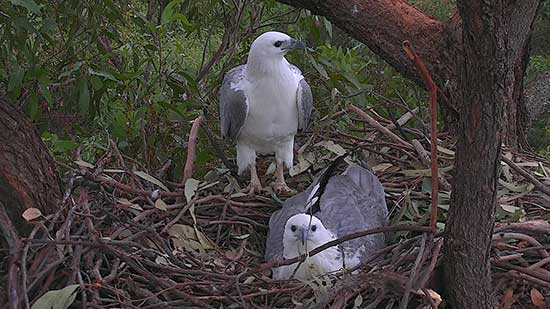
The first egg SE-17 was laid 19 June 2016 - 09:00pm.
The second egg SE-18 was laid 23 June 2016 - 01:15am.
Around 77 hours apart. Previously, the time between laying of the two eggs has varied from three to five days (when we were able to observe the lay). Even with a different female, there seems to be a definite trend for delayed incubation between the first egg laid and the second. On the first day after the first egg was laid, the egg was uncovered for nearly 11 hours in total. On day two, the time the egg was uncovered was around six hours. At night, again, only the female incubated and on the first night after lay the previous night, she left the egg uncovered for more than four hours at one time, noting it was Winter and cold. Both eagles shared incubation during the day, though again in the early stages after the first egg was laid, nest posture probably indicated guarding rather than full incubation. The male on day one spent seven hours incubating during the day, compared with just under four hours by the female. The female spent gradually more time on the nest each day before the second egg was laid. Though the eggs were laid about 77 hours apart, the second eaglet hatched around 36.5 hours after the first, suggesting a tactic of delayed incubation, with the second chick given the opportunity to “catch up” with the first.
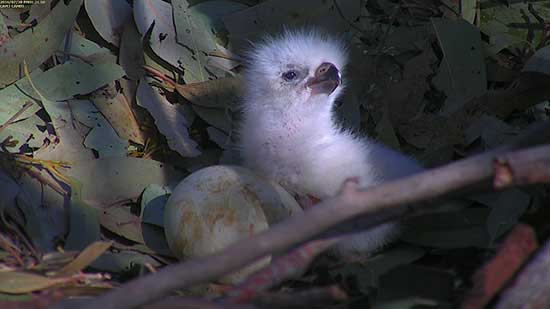
The first chick SE-17 , hatched after 40 days incubation around 8:30pm on Friday 29 July after pipping around 2:00pm the previous day. Hatching took just over 30 hours, a long process.
The second chick SE-18 , hatched around 7:00am on Sunday 31 July, some 22 hours after pipping on Saturday morning. Both chicks were heard cheeping from inside the egg, as they struggled to gradually chip their way free. Both parents brooded the young, brought food and cared for the young, as in past years.
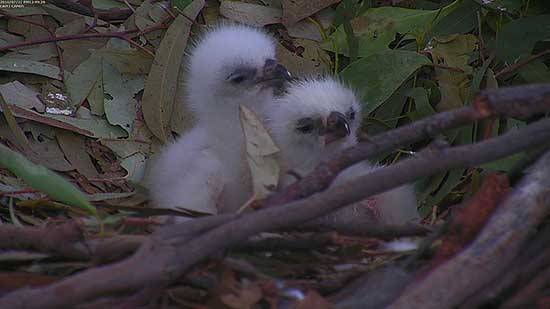
Eagles may exhibit "obligate siblicide," in which the larger chick invariably kills its smaller sibling. We have not observed this in our study, although the younger and smaller eaglet SE-18 gradually became weaker. After about 10 days, (10 August 2016) SE-18 was no longer visible in the nest and was probably under the leaves lining the nest. The parents were not seen to have removed the body or eat it. Its death was probably the result of a number of factors including sibling rivalry, insufficient food and poor weather conditions, including heavy rain. The surviving chick continued to thrive, with plenty of prey brought to the nest.
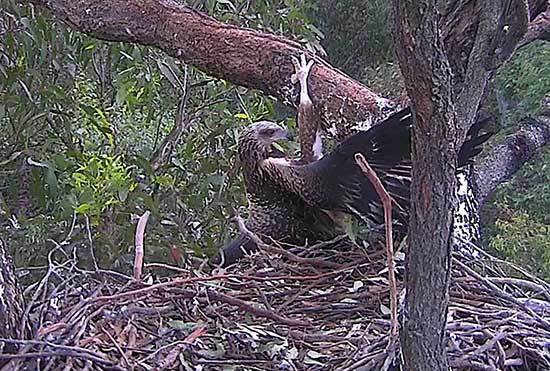
By late September SE-17 was exercising vigorously, flapping its wings and lifting just off the nest. On October 18, at around 11 weeks, SE-17 branched, flapping to a branch just above the nest. Unfortunately, the next day he missed landing in the nest after another branching, and fell to the ground. As a fox had been seen close by and it was uncertain if the eaglet was injured, a decision was made to intervene. After discussion and approval from the relevant authorities, the eaglet was captured, and taken to the Taronga Wildlife Hospital. SE-17 was examined and given some nourishment. One juvenile from the previous year had been diagnosed with beak and feather disease. This condition is also referred to as: Non-Psittacine beak and feather disease, Non-Psittacine Circoviral Disease or Circovirus. When his condition continued to worsen, euthanasia was recommended. SE-17 was found to be healthy, not suffering from the circovirus and it was recommended he should be returned to the nest. It was confirmed he was a male.
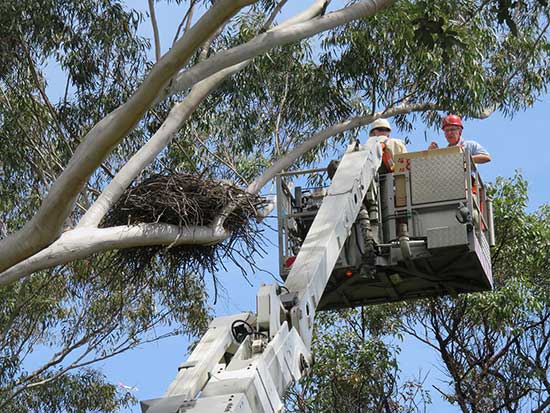
After consultation with the National Parks and Wildlife Service (NPWS), he was returned to nearby nest two. This nest could be reached with a cherry-picker and the eagles had been observed visiting this nest. It was considered unsafe to attempt to return the eaglet to the current nest, that could only be reached by climbing and ropes. Although food was left in the nest and the team retreated quickly, the eaglet attempted to fly and left the nest. He was found on the ground nearby. There was some concern felt as he had not taken food, was an inexperienced flier, and we were not sure if the adults would return.
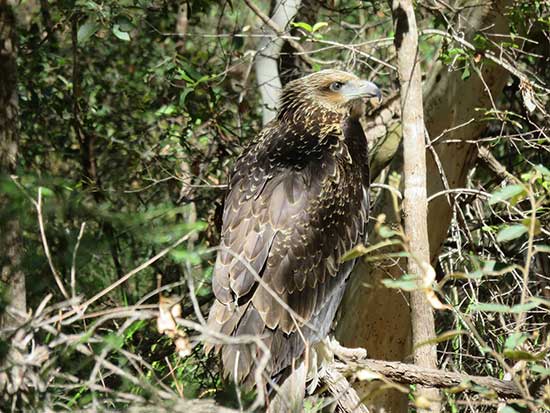
Over the following weeks, SE-17 was seen in the Nature Reserve Saltmash and wetlands and was observed flying. It is presumed the adults brought food to the juvenile. He was also heard calling from the Saltmarsh. Again, disturbance was kept to a minimum. During November and December he was seen several times in the Saltmarsh and once flying across the river. The adults were seen each day on the usual river roost mangroves, or flying over the wetlands. They were also observed in the nest area and roosting in the forest at night. The last confirmed sighting of SE-17 was on 26 December.
The previous pair nested every year since 2009 with an average of one young fledged per breeding attempt. They laid two eggs in each year, giving a mortality rate of 50 percent, “mortality” meaning eggs that failed to hatch or young that died in the nest. The current pair has shown a similar result. Compared to other studies conducted over several years they still maintain a normal “success” rate after many years of failed breeding.
As in previous years, a variety of prey has been brought to the nest: several species of fish including mullet, bream, whiting, flathead as well as eels and birds, mainly Silver Gulls. Both adults bring food, though more was brought by the male. Late in the season, SE-17 was observed snatching prey from the parents at the nest and feeding himself. However, he was not observed feeding or taking prey from the wetlands after his premature flight from the nest area. His presence is unknown.
www.environment.nsw.gov.au/threatenedspeciesapp/profile.aspx?id=20322

